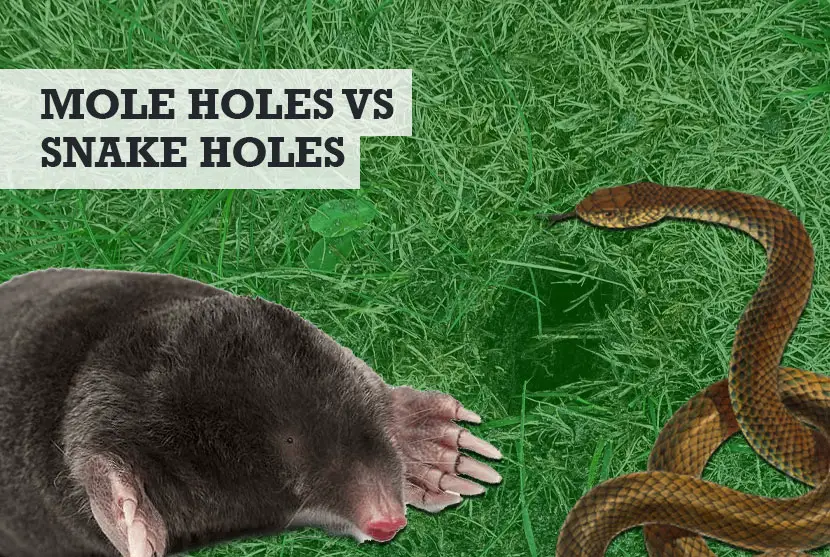Seeing holes and mounds of earth appearing in a backyard is enough to send most people crazy, particularly if you’ve spent so much time creating the perfect outdoor environment. It can also induce anxiety if you suspect the holes have been made by snakes or moles.
But let’s get one thing straight before I continue: when it comes to the mole holes vs snake holes debate, I know which I’d rather have in my yard.
It’s snakes over moles, each, and every time… let me explain my reasoning.
Snakes won’t do any damage to your backyard or garden, but moles most certainly will. In fact, such is the extent to which moles will burrow and tunnel, it’s even a potential risk to your home.
In this guide, I will explain to you how (or rather, how you can’t really) differentiate between mole holes vs snake holes, and for a good reason.
Please take the time to read this, because it explains why moles are such a problem in your backyard. Not just to your lawn, but also hard standing areas such as patios and possibly the foundations of your home.
What do mole holes look like vs snake holes?
In simple terms, there’s no sure-fire way of identifying a snake hole versus a mole hole unless you see the creature coming in and out. The reason being is that snakes don’t tend to dig holes.
Unlike how moles, snakes can’t dig and tunnel into compacted soil and earth, the type of which you get in a backyard or garden lawn.
Instead, snakes are opportunistic reptiles and will find a hole that another animal has already made, and then make it their own. Snakes like warmth and hiding places, so a hole that perhaps a mole, rat, or chipmunk has made will be perfect for them to live or hibernate in.
Handy Hint: Here’s how to compare chipmunk hole vs a snake hole.
But that’s not to say snakes can’t make holes in your yard at all. They can, but only in soft vegetation and loose soil. And then when they do, it tends to be more of a hole to curl up in, rather than a hole that leads into an underground tunnel system.
And underground tunnel systems are exactly how moles make holes.
Moles will burrow holes and tunnels than can be up to a meter under your backyard lawn, and (almost unbelievably) can be as long as 70 meters. They don’t stop there either. Moles holes can continually be expanded year on year. They truly are the greedy property developers of the animal world.
The BIG difference between a hole a mole lives in vs hole a snake lives in
“Most mole holes won’t actually have a visible hole, but instead a mound of earth. Snakes will live in holes with a visible opening, as they cannot dig.”
Compare a mole hole to a hole a snake lives in, and you might be able to see one big difference. And I say that only if a snake has found soft enough material to make a hole into. It’s unlikely it will to be honest, and even if snake could dig a hole, it won’t create damage like a mole hole will.
Moles will also leave mounds of earth outside their holes. Snakes won’t.
But that doesn’t mean you don’t have both living in your yard.
Moles might have made the holes, and snakes might then have moved in. And in truth, that’s not an unlikely scenario, because moles are afraid of snakes, that if one went in their hole, the moles would quickly pack up and leave, never to return.
This leaves the question though of what or who is living in the holes in your yard. Is it moles or snakes in the holes, no matter who made the holes originally.
What does a mole hole look like?
Well, firstly let’s look at what a mole hole looks like.

Moles will burrow holes that that then have a mound of soil on top of the lawn. Most mole holes also won’t have an open hole on the surface. Compare this to a hole a snake is using, and you will see a very visible hole.
If you see lots of evidence of mole holes within a 10-meter area, it possible they have been dug by just one mole. They are territorial and tend to be alone in your backyard.
It’s also worth mentioning that mole activity is usually at its peak in late winter and early spring times.
How to test if it’s a mole hole vs a snake hole habitat
If you’ve not seen a mole (or snake) there are some tell-tale signs of mole activity. Signs of mole damage include:
- Heaps or mounds of excavated earth on the surface of your backyard lawn or flower beds. In other words, mole hills! A hole a snake lives in will be a visible hole, a mole’s won’t.
- Collapsed areas on the lawn where a tunnel is.
- Disturbed roots or seedlings of new plants that are yet to take hold properly.
Snakes do not do damage like this, and in fact, snakes are great for your yard’s ecosystem. They can keep also keep rodents away, such as rats and chipmunks, as well as insects you don’t want.
Therefore, I would rather have a snake hole vs a mole hole. I do not want moles living in my backyard and near my home at all, for reasons I will explain in a moment.
If moles do dig holes in my garden or backyard, I’d love a non-venomous snake to come along, scare them off, and take the hole over as their own.
Handy Hint: Here’s what you can when you find out Copperhead snakes are living in your backyard.
But how do you truly know whether it’s a mole or snake in the hole? Well, one way you can test is by filling the hole with tightly compacted earth and soil.
A snake living in the hole will not be able to dig back in. On the other hand, if you fill a hole a mole lives in, it’s no barrier to their digging skills. The rodent will easily tunnel through the dirt and make a hole again.
Also keep an eye out for snakeskins. If a snake lives in the mole’s hole, it will often shed nearby, and you will see the dry skins left in your yard.
I’d rather snakes live in a hole than mole
As you can gather, I am no fan of moles, and in truth, I don’t really want snakes living in my backyard either. But give me a choice, and I’d rather snakes in a hole than moles in a hole, and here’s the biggest reason why.
Whilst moles will not eat your plants (they are carnivores), they can do damage in other ways as their tunnelling displaces dirt, roots, and seeds of what you’ve planted.
But by far, the biggest reason I’d rather snakes win the battle of living in a hole, is the damage moles can potentially do to property.
Moles create very long tunnels which can reach underneath driveways, patios, porches, walls, and even the foundations of your home. Given how extensive their tunnelling can be, it’s possible that mole tunnel networks will result in the weakening of structures, walls, and damage to property.
It will cost a lot to repair damage due to ground collapsing after mole activity.
Snakes in your backyard will do nothing of the sort, and in fact, snakes will scare moles away… so if you see mole holes with earth piles next to them, hope snakes live in them, and not rodents!
Handy Hint: Have you considered that it could be a crawfish hole, and not a snake or mole?
How to get rid of moles in your yard
If there are no snakes, and it is indeed moles in the holes, here are 5 humane ways you can get rid of them from your backyard.
- Electronic deterrents: this device on Amazon (click pic below) emits sonic pulses that you can’t hear, but moles can, and they are said to hate it and will leave your yard.
- Humane mole repellents: you can also buy granules on Amazon that you put in your yard, a mole will taste it, hate it, and hopefully move on sharpish!
- Mole netting: this is more preventative, as you place the netting underneath a lawn before it’s laid. It’s not a favorite of mine, as it’s adding plastic to the ecosystem of your yard.
Conclusion
In conclusion, it’s far better to have a snake in a hole, than a mole in a hole. If you see holes, hope it’s a snake, as they won’t cause damage to your backyard plants, lawn, and above all, your home!



